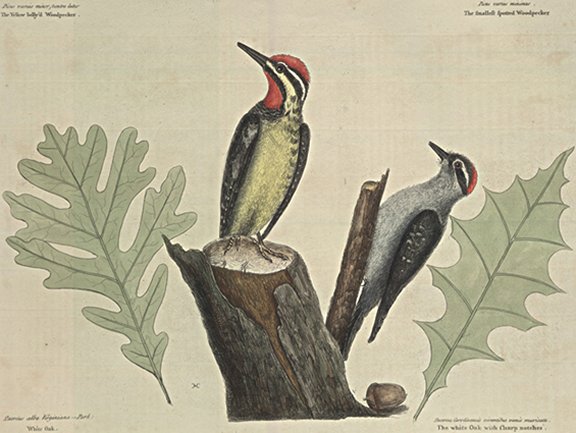Plate Number: I 21Picus Various Minor, Ventre Luteo: The yellow belly'd Wood-pecker Weighs one ounce thirteen penny weight. Its Bill is of a lead colour; all the upper part of the Head is red, bordered below with a lift of black under which runs a lift of white, parallel with which runs a black lift from the Eyes to the back of the Head, under which it is pale yellow: The throat is red and bordered round with black: On the Neck and Back the feathers are black and white, with a tincture of greenish yellow: The Breast and Belly are of a light yellow, with some black feathers intermix'd: The Wings are black, except towards the shoulders where there are some white feathers; and both edges of the Quill-feathers are spotted with White: the Tail is black and white. The Hen is distinguishable by not having any red about her. Picus Varius Minimus: The Smallest Spotted Wood-peckerWeighs fourteen penny-weight. It so nearly resmbles the Hairy Wood-pecker, Tab. 19. in its marks and colour, that were it not for disparity of size, they might be thought to be the same. The Breast and Belly of this are light gray: The four uppermost feathers of the Tail are black: the rest are gradually shorter, and transversely marked with Black and White: The Legs and Feet are black. Thus far this differs from the description of the above mentioned. The Hen differs from the Cock in nothing but wanting the red spot on its Head. Quercus alba Virginiana, Park; The White OakThis nearest resembles our common English Oak in the shape of its Leaves, Acorns, and Manner of growing; the Bark is White, the grain of the Wood fine, for which and its durableness it is esteem'd the best Oak in Virginia and Carolina. It grows on all kind of Land; but most on high barren Ground amongst Pine Trees. There is another kind of white Oak, which in Virginia is called the Scaly white Oak, with Leaves like this, the Bark white and scaly, the Wood is of great use in building. They grow on rich Land both high and low. Quercus Carolinensis virentibus venis muricata: The White Oak, with pointed NotchesThe leaves of this Oak are notched and have sharp points. The Bark and Wood is white, but has not so close a grain as the precedent. Dr. Pluknet has figured a leaf shaped like this by the Name of Quercus Virginiana rubris venis muricata. This has no red Veins. Vide Pluk. Phytograph. Tab. LIV. fig. 5. Syringa Baccifera, Myrti subrotundis foliis, floribus albis gemellis ex provincia Floridana. This plant grows in moist Places, usually under trees, on which it sometimes creeps a little way up, but most commonly trails on the Ground, many Stems rising close together near the Ground, about six inches long, which have some side Branches: the Leaves are small, in form of a heart, and grow opposite to each other on very small foot-stalks: it's Flowers are tetrapetalous, very small, and in form and colour like those of the white Lilach, and are succeeded by red berries of an Oval form and of the size of large peas, having two small holes, and contain many small Seeds. It retains the leaves all the Year. |